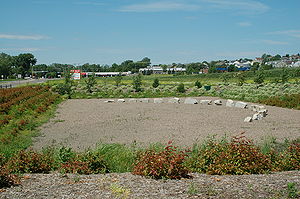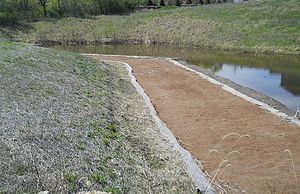
Types of iron enhanced sand filter
This page describes two types of iron-enhanced practices - sand filters and pond benches.
Iron-enhanced sand filter basin
An iron-enhanced sand filter basin is similar to a surface sand filter with iron mixed evenly throughout a portion of the filtration media. Surface sand filter design and operating parameters also applicable to iron-enhanced sand filter basins include
- the use of a flow splitter to control inflow volume;
- required pretreatment per the MPCA’s General Construction Stormwater Permit;
- filtration bed depth (approximately 18 inches); and
- use of perforated pipes (or other appropriate drain pipe design) in a gravel bed to drain the filter.
To prepare the best management practice (bmp) for runoff from the next storm event and because the filter bed contains iron which can foul the filter, the bed should drain within 48 hours of storm completion.
If the iron-enhanced sand filter lies below the groundwater table, an Level 1 impermeable liner may be necessary to prevent groundwater inflows. The Construction Stormwater Permit requires a liner for a filtration system with less than 3 feet of separation to the seasonally saturated water table. A Level 1 liner is recommended.
Iron-enhanced sand bench in wet ponds
An iron-enhanced sand bench in wet ponds consists of a wet pond with an iron-sand trench along the perimeter of the pond. The elevation at the top of the trench is at the normal water elevation of the pond. During a storm event, water rises above the trench elevation and fills the live storage area of the pond. Stormwater will filter through the bench with excess stormwater bypassing the bench. Along with watershed, storm event, and pond geometry variables, the volume of stormwater passing through the bench will depend upon the outlet structure design.
Many of the design and operating considerations of an iron-enhanced sand filter basin also apply to the iron-enhanced sand bench. In addition to the 48-hour drain dry time, to prevent pond drawdown below the normal water level and allow the trench to dry and aerate, a geomembrane liner needs to be placed or the soils between the pond and the sand bench needs to be prepared to inhibit infiltration from the pond into the trench. A Level 1 liner is recommended.
Related pages
- Overview for iron enhanced sand filter
- Types of iron enhanced sand filter
- Design criteria for iron enhanced sand filter
- Operation and maintenance of iron enhanced sand filter
- Calculating credits for iron enhanced sand filter
- References for iron enhanced sand filter
- Supporting material for iron enhanced sand filter
This page was last edited on 23 November 2022, at 22:42.





